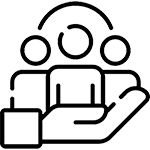What is employment?
An employment process is like a plan to find a job. It helps you figure out how to search for a job, prepare your job application materials (like your resume and cover letter), apply for jobs, and get ready for interviews. The goal is to find a job that suits you and helps you support yourself.
Why find a job ?
Working is a crucial step in your reintegration, since it allows you to reintegrate into society. In fact, a job will help you support yourself.
How can I find a job?
When you are ready to find a job, you can discuss it with your caseworker, as they may have a list of employers who are open to hiring someone with a criminal record.
To start your employment process:
- Find someone you trust to help you.
- Choose the type of job you want to do.
- Look for job opportunities from friends, online job sites, or your caseworker.
- Write your resume and cover letter.
To fin a job, you can follow the steps:

Step 1: Talk to people you know to see if they know of any job openings.

Step 2: Search for jobs on websites like the Government of Canada job bank or Quebec government job bank.

Step 3: Create a resume and cover letter that highlights your skills and why you want the job.

Step 4: Apply for jobs that match your skills and interests.

Step 5: Prepare for interviews by practicing your answers to common questions.

Step 6: Dress appropriately and show up on time for interviews.
Your CV
Several models are available online or in Word. The functional CV is ideal for people who have a period of inactivity, a career change or an atypical career path.
What can you find on a functional CV?
- Your name and contact information in the header
- A catchphrase/tagline (optional)
- Your skills and qualifications
- Your training/schooling
- Your work experience last 2 or 3 jobs

What are the advantages of the functional CV?
- It is limited to one page;
- It prioritizes your experiences, skills, and qualifications;
- The dates and duration of employment are not included.
Your cover letter
A cover letter is written on a single page. It explains why you are contacting the company and emphasizes what you could bring to the company where you want to work.
What can you find on a cover letter?
- Start with a polite statement;
- Explain why you want to work for this company;
- Highlight your skills related to the desired position: why should they hire you?
- Summarize your CV: what are your strengths, qualifications, and experience?
- Repeat why the job interests you?
- Conclude the letter: thank the reader and end the letter with an invitation to contact you (e.g.: looking forward to meeting you shortly)
- Sign your letter

Before applying, check the deadline. There is no point in applying for an expired offer.
Prepare for your interview
The job interview can be a stressful time, so it is important to prepare well to reduce your anxiety.
- Reread your cover letter and CV
- Imagine the questions you will be asked and prepare your answers. For example: Why do you want to work with us? What are your biggest weaknesses? Can you tell me about yourself?
- Show up for your interview
- A few days before your interview, check the itinerary and the time needed to get to your meeting location. Remember to relax the morning of your interview and arrive a few minutes before your official appointment time.
- During the interview, make sure you are yourself while dressing appropriately for the position you are applying for.
If you do not get a job right away, do not be discouraged and continue your search. A job suited to your skills and priorities is waiting for you somewhere!
What goal can I set myself to find a job?
- Consult job sites 30 minutes per day
- Make a list of 10 companies where I want to apply
- Update my CV on 3 job sites
- Speak to 10 contacts about my job search
- Send 15 Cvs per week
Set your goals!

 Documents
Documents Infographics
Infographics External help
External help